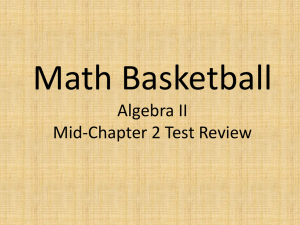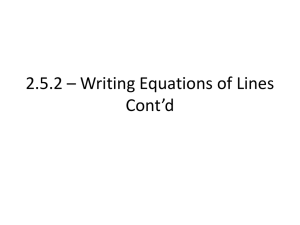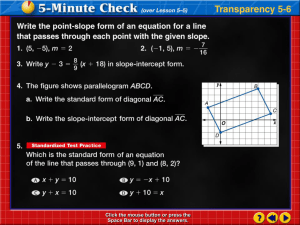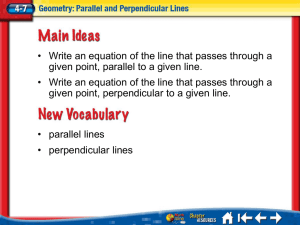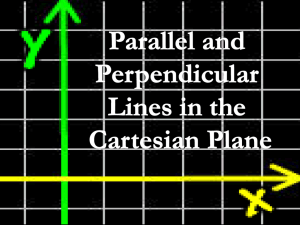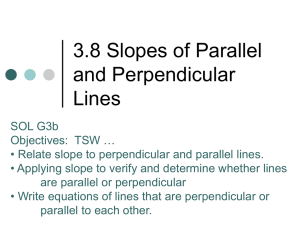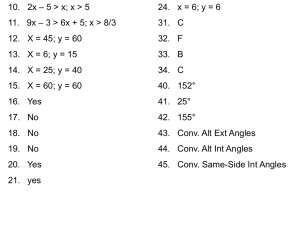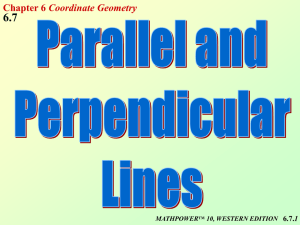Parallel and Perpendicular Lines
advertisement
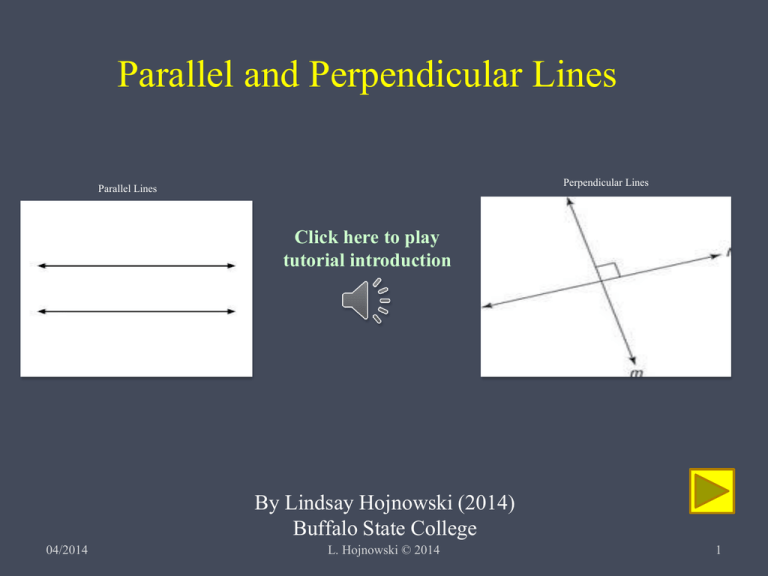
Parallel and Perpendicular Lines Perpendicular Lines Parallel Lines Click here to play tutorial introduction By Lindsay Hojnowski (2014) Buffalo State College 04/2014 L. Hojnowski © 2014 1 Aim for the Target Learning Objectives • The learner will be able to put the equations in slope-intercept form to identify the slope 85% of the time. • The learner will be able to identify what the parallel or perpendicular slope is 85% of the time. • Student wills be able to use the point-slope formula to find parallel lines given a point and a line (using the given slope) 80% of the time. • Students will be able to use the point-slope formula to find perpendicular lines given a point and a line (using the given slope) 80% of the time. 04/2014 L. Hojnowski © 2014 2 Menu Characteristics of Parallel Lines Perpendicular Lines- Example 1 Quiz Question #1 Parallel Lines- Steps Given a point and an equation Perpendicular Lines- Example 2 Quiz Question #2 Parallel Lines- Example 1 Perpendicular Lines- Example 3 Quiz Question #3 Parallel Lines- Example 2 Determine whether parallel, perpendicular, or neither- Steps Quiz Question #4 Parallel Lines- Example 3 Determine- Example 1 Quiz Question #5 Characteristics of Perpendicular Lines Determine- Example 2 Perpendicular Lines- Steps Given a point and an equation Determine- Example 3 Quiz Question #6 Quiz Question #7 References 04/2014 L. Hojnowski © 2014 3 Characteristics of Parallel Lines Parallel lines: 1) 2) Are lines that do not intersect Have different y-intercepts - Click on the picture below to see a video on how to write a parallel line to another line using point-slope form Parallel Lines- JMAP Video 04/2014 L. Hojnowski © 2014 4 Parallel Lines- Steps Given a point and an equation STEPS: 1) Rewrite the given equation into slopeintercept from (y = mx + b), if necessary, and identify the slope (m) 2) Plug in the given point and the parallel slope (found in step 1) in the point-slope formula (y – y1 = m (x – x1) 3) Distribute and simplify (if necessary) 4) Solve for y 04/2014 L. Hojnowski © 2014 Steps to writing a parallel line 5 Parallel Lines- Example 1 STEPS: 1) Rewrite the given equation into slope-intercept from (y = mx + b), if necessary, and identify the slope (m) 2) Plug in the given point and the parallel slope (found in step 1) in the point-slope formula (y – y1 = m (x – x1) 3) Distribute and simplify (if necessary) 4) Solve for y Example 1: Write an equation in slope-intercept form for the line that passes through (-2, 2) and is parallel to y = 4x – 2. **Use the point-slope formula** 1) The equation is in slope-intercept form, m = 4 2) y – y1 = m (x – x1) y – 2 = 4 (x - - 2) y – 2 = 4 (x + 2) 04/2014 3) y – 2 = 4 (x + 2) y – 2 = 4x + 8 +2 +2 4) y = 4x + 10 L. Hojnowski © 2014 6 Parallel Lines- Example 2 STEPS: 1) Rewrite the given equation into slope-intercept from (y = mx + b), if necessary, and identify the slope (m) 2) Plug in the given point and the parallel slope (found in step 1) in the point-slope formula (y – y1 = m (x – x1) 3) Distribute and simplify (if necessary) 4) Solve for y Example 2: Write an equation in slope-intercept form for the line that passes through (6, 4) and is parallel to y = (1/3)x + 1. **Use the point-slope formula** 1) The equation is in slope-intercept form, m = 1/3 2) y – y1 = m (x – x1) y – 4 = (1/3) (x - 6) 3) y – 4 = (1/3) (x - 6) y – 4 = (1/3)x - 2 +4 +4 4) y = (1/3)x + 2 04/2014 L. Hojnowski © 2014 7 Parallel Lines- Example 3 Example 3: Write an equation in slope-intercept form for the line that passes through (-1, 6) and is parallel to 3x + y = 12. **Use the point-slope formula** The equation is NOT in slope-intercept form, m = ? **In order to identify the slope, solve for y! 3x + y = 12 -3x -3x y = -3x +12 3) y – 6 = -3 (x – -1) y – 6 = -3 (x + 1) y – 6 = -3x - 3 m = -3 4) y – 6 = -3x - 3 +6 +6 y = -3x +3 2) y – y1 = m (x – x1) y – 6 = -3 (x – -1) 04/2014 Example of a given point and a line L. Hojnowski © 2014 8 Characteristics of Perpendicular Lines Perpendicular Lines: 1) 2) Are lines that intersect at right angles Have negative reciprocal slopes -Example: m = 2 m = -1/2 - Click on the picture below to see a video to review how to write a perpendicular line to another line using slope-intercept form (you can use point-slope formula just like parallel lines) Perpendicular Lines- JMAP Video 04/2014 L. Hojnowski © 2014 9 Perpendicular Lines- Steps Given a point and an equation STEPS: 1) Rewrite the given equation into slopeintercept from (y = mx + b), if necessary, and identify the slope (m) 2) Plug in the given point and the perpendicular slope (negative reciprocal) in the point-slope formula (y – y1 = m (x – x1) 3) Distribute and simplify (if necessary) 4) Solve for y 04/2014 L. Hojnowski © 2014 Steps to writing a perpendicular l line 10 Perpendicular Lines- Example 1 STEPS: 1) Rewrite the given equation into slope-intercept from (y = mx + b), if necessary, and identify the slope (m) 2) Plug in the given point and the perpendicular slope (negative reciprocal) in the point-slope formula (y – y1 = m (x – x1) 3) Distribute and simplify (if necessary) 4) Solve for y Example 1: Write an equation in slope-intercept form for the line that passes through (4, 2) and is perpendicular to y = (1/2)x + 1. **Use the point-slope formula** 1) The equation is in slope-intercept form, m = (1/2) Perpendicular slope: -2 2) y – y1 = m (x – x1) y – 2 = -2 (x - 4) 04/2014 L. Hojnowski © 2014 3) y – 2 = -2 (x - 4) y – 2 = -2x + 8 +2 +2 4) y= -2x + 10 11 Perpendicular Lines- Example 2 STEPS: 1) Rewrite the given equation into slope-intercept from (y = mx + b), if necessary, and identify the slope (m) 2) Plug in the given point and the perpendicular slope (negative reciprocal) in the point-slope formula (y – y1 = m (x – x1) 3) Distribute and simplify (if necessary) 4) Solve for y Example 2: Write an equation in slope-intercept form for the line that passes through (-5, -1) and is perpendicular to y = (5/2)x - 3. **Use the point-slope formula** 1) The equation is in slope-intercept form, m = (5/2) Perpendicular slope: (-2/5) 2) y – y1 = m (x – x1) y – -1 = (-2/5) (x - - 5) 04/2014 L. Hojnowski © 2014 3) y + 1= (-2/5) (x + 5) y + 1= (-2/5)x - 2 -1 -1 4) y= (-2/5)x - 3 12 Perpendicular Lines- Example 3 Example 3: Write an equation in slope-intercept form for the line that passes through (-4, 6) and is perpendicular to 2x + 3y = 12. **Use the point-slope formula** 1) The equation is NOT in slope-intercept form, m = ? **In order to identify the slope, solve for y! 2x + 3y = 12 2) y – y1 = m (x – x1) -2x -2x y – 6 = (3/2)(x – -4) 3y = -2x + 12 3 3 y = (-2/3)x + 4 m = -2/3 Perpendicular slope: (3/2) 3) y – 6 = (3/2)(x + 4) y – 6 = (3/2)x + 6 +6 +6 4) y = (3/2)x + 12 Given a Point and a Line 04/2014 L. Hojnowski © 2014 13 Determine whether parallel, perpendicular, or neither- Steps STEPS: 1) Rewrite both equation into slope-intercept form (y = mx + b) and identify each slope 2) Compare the slopes to see if they are the same, negative reciprocal, or neither Example of Parallel Lines- Same Slope 04/2014 Example of Perpendicular l LinesNegative Reciprocal Slope L. Hojnowski © 2014 Example of Neither Parallel or Perpendicular Lines 14 Determine whether parallel, perpendicular, or neither- Example 1 STEPS: 1) Rewrite both equation into slope-intercept form (y = mx + b) and identify each slope 2) Compare the slopes to see if they are the same, negative reciprocal, or neither Example1: Determine whether the graphs of the pair of equations are parallel, perpendicular, or neither. 3x + 5y = 10 5x – 3y = -6 5x – 3y = -6 3x + 5y = 10 -5x -5x -3x -3x -3y = -5x - 6 5y = -3x + 10 -3 -3 5 5 y = (-5/-3)x + 2 y = (-3/5)x + 2 m = (5/3) m = (-3/5) PERPENDICULAR- they have negative reciprocal slopes 04/2014 L. Hojnowski © 2014 15 Determine whether parallel, perpendicular, or neither- Example 2 STEPS: 1) Rewrite both equation into slope-intercept form (y = mx + b) and identify each slope 2) Compare the slopes to see if they are the same, negative reciprocal, or neither Example 2: Determine whether the graphs of the pair of equations are parallel, perpendicular, or neither. 2x - 8y = -24 x – 4y = 4 x – 4y = 4 2x - 8y = -24 -x -x -2x -2x -4y = -x + 4 -8y = -2x - 24 -4 -4 -8 -8 y = (-1/-4)x - 1 y = (-2/-8)x + 3 m = (1/4) m = (1/4) PARALLEL- they have the same slope 04/2014 L. Hojnowski © 2014 16 Determine whether parallel, perpendicular, or neither- Example 3 Example 3: Determine whether the graphs of the pair of equations are parallel, perpendicular, or neither. -3x + 4y = 8 -4x + 3y = -6 -4x + 3y = -6 +4x +4x 3y = 4x - 6 3 3 y = (4/3)x - 2 m = (4/3) -3x + 4y = 8 +3x +3x 4y = 3x + 8 4 4 y = (3/4)x + 2 m = (3/4) NEITHER- they aren’t the same slope and are not negative reciprocals They are reciprocals but not negative reciprocals 04/2014 L. Hojnowski © 2014 17 Quiz Question #1 1. What is the perpendicular slope of the line that passes through the line: y = (-3/4)x + 4 ? a. -4/3 04/2014 b. 3/4 c. 4/3 L. Hojnowski © 2014 d. -3/4 18 Quiz Question # 2 2. Which line is parallel to the line 4x + y = 3? a. y = (1/4) x – 1 04/2014 b. y = 4x + 2 c. y = (-1/4) x – 6 L. Hojnowski © 2014 d. y = -4x + 5 23 Quiz Question # 3 3. What is the slope of the line 2x + 7y = -35? a. 2/7 04/2014 b. -2/7 c. 7/2 L. Hojnowski © 2014 d. -7/2 28 Quiz Question # 4 4. Write an equation in slope-intercept form for the line that passes through (0, 4) and is parallel to y = -4x + 5. a. y = -4x 04/2014 b. y = -4x - 4 c. y = (1/4)x + 4 L. Hojnowski © 2014 d. y = -4x + 4 33 Quiz Question # 5 5. Write an equation in slope-intercept form for the line that passes through (-8, 0) and is perpendicular to y = (-1/2)x - 4 a. y = (-1/2)x - 4 04/2014 b. y = 2x + 16 c. y = -2x - 16 L. Hojnowski © 2014 d. y = (1/2)x + 4 38 Quiz Question # 6 6. Determine whether 2x + 7y = -35 and 4x + 14y = -42 are parallel, perpendicular, or neither. a. neither 04/2014 b. parallel L. Hojnowski © 2014 c. perpendicular 43 Quiz Question # 7 6. Determine whether 3x + 5y = 10 and 5x – 3y= -6 are parallel, perpendicular, or neither. a. neither 04/2014 b. parallel L. Hojnowski © 2014 c. perpendicular 47 Reference from the dictionary References • McGraw-Hill Companies. (2014). Glencoe Algebra 1 Common Core Edition. New York: McGraw Hill. • Seminars.usb.ac.ir. (2011). Hitting the objectives, Retrieved on September 14th, 2012, from • http://www.teambuildinggames.org/role-of-the-team-buildingfacilitator. • Smiley Face, Retrieved on September 14th, 2012, from http://ed101.bu.edu/StudentDoc/current/ED101fa10/rajensen/ima ges/happy-face1.png. • Wee, E. (2011). Try again, Retrieved on September 15th, 2012, from http://radionjournals.blogspot.com/2011/04/try-again-part3-caring-for-children.html. 04/2014 L. Hojnowski © 2014 51
